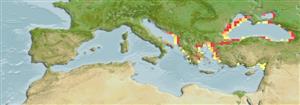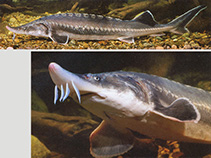Beobachtung melden im Fish Watcher
| Native range | All suitable habitat | Point map | Year 2050 |

|
| This map was computer-generated and has not yet been reviewed. |
| Huso huso AquaMaps Data sources: GBIF OBIS |
Hochladen Photos und videos
Pictures | Stamps, coins, misc. | Google BildHuso huso
Picture by Hartl, A.
Pictures | Stamps, coins, misc. | Google BildHuso huso
Picture by Hartl, A.
Bulgaria country information
Common names:
Moruna
Occurrence: native
Salinity: freshwater
Abundance: | Ref:
Importance: | Ref:
Aquaculture: | Ref:
Regulations: | Ref:
Uses: no uses
Comments:
National Checklist:
Country Information: https://www.cia.gov/library/publications/resources/the-world-factbook/geos/bu.html
National Fisheries Authority:
Occurrences: Occurrences Point map
Main Ref: Blanc, M., J.-L. Gaudet, P. Banarescu and J.-C. Hureau, 1971
National Database:
Occurrence: native
Salinity: freshwater
Abundance: | Ref:
Importance: | Ref:
Aquaculture: | Ref:
Regulations: | Ref:
Uses: no uses
Comments:
National Checklist:
Country Information: https://www.cia.gov/library/publications/resources/the-world-factbook/geos/bu.html
National Fisheries Authority:
Occurrences: Occurrences Point map
Main Ref: Blanc, M., J.-L. Gaudet, P. Banarescu and J.-C. Hureau, 1971
National Database:
Common names from other countries
Klassifizierung / Names Namen | Synonyme | Catalog of Fishes(Gattung, Arten) | ITIS | CoL | WoRMS | Cloffa
> Acipenseriformes (Sturgeons and paddlefishes) > Acipenseridae (Sturgeons) > Acipenserinae
Etymology: Huso: Latin, huso = swine (Ref. 45335).
More on author: Linnaeus.
Etymology: Huso: Latin, huso = swine (Ref. 45335).
More on author: Linnaeus.
Environment: milieu / climate zone / depth range / distribution range Ökologie
seewasser; süßwasser; brackwasser; anadrom (Ref. 51243); tiefenbereich 70 - 180 m. Temperate; 10°C - 20°C (Ref. 2059); 57°N - 35°N, 13°E - 60°E
Verbreitung Länder | FAO Gebiete | Ecosystems | Vorkommen | Point map | Einführungen | Faunafri
Eurasia: Caspian, Black, Azov and Adriatic Sea basins.
Extirpated from Adriatic Sea.
Length at first maturity / Size / Gewicht / Alter
Maturity: Lm ?, range 200 - ? cm
Max length : 800 cm TL Männchen/unbestimmt; (Ref. 59043); common length : 215 cm TL Männchen/unbestimmt; (Ref. 3397); max. veröff. Gewicht: 3.2 t (Ref. 59043); max. veröff. Alter: 118 Jahre (Ref. 47437)
Max length : 800 cm TL Männchen/unbestimmt; (Ref. 59043); common length : 215 cm TL Männchen/unbestimmt; (Ref. 3397); max. veröff. Gewicht: 3.2 t (Ref. 59043); max. veröff. Alter: 118 Jahre (Ref. 47437)
Kurzbeschreibung Bestimmungsschlüssel | Morphologie | Morphometrie
Rückenflossenstacheln (insgesamt) : 0; Rückenflossenweichstrahlen (insgesamt) : 62 - 73; Afterflossenstacheln: 0; Afterflossenweichstrahlen: 28 - 41. Snout moderate and pointed, turning slightly upward. Lower lip not continuous, interrupted at center. Barbels oval or flat, leaf-like posteriorly, reaching almost to mouth. Five rows of scutes, dorsal 11-14 (first one smallest), lateral 41-52 on each side, ventral 9-11 on each side. Back ash-grey or greenish, flanks lighter, belly white.
Pelagic at the sea, following its prey. Undertakes upriver migration to spawn. Juveniles occur in shallow riverine habitats during their first summer. Spawns in the main course of large and deep rivers with strong current and on stone or gravel bottom (Ref. 59043). Feeds mostly on sea fishes (Black Sea whiting, anchovies, flatfishes, gobies, fry of bottom-living fishes), also crustaceans, mollusks, mysids and amphipods. Fisheries are based almost entirely on the value of the caviar, but meat also is sold fresh, smoked and frozen; eaten broiled, boiled, fried and baked (Ref. 9988). Bester, a hybrid of female Huso huso and male sterlet Acipenser ruthenus, has been successfully cultivated for its high quality eggs (Ref. 9988). The largest sturgeon and largest European freshwater fish. In Guinness Book of Records as the most expensive fish (Ref. 6472). Threatened due to overfishing for meat at the sea and for caviar in estuaries. These threats will soon cause global extinction of the natural populations. Survival can only depend on stocking (Ref. 59043).
Life cycle and mating behavior Geschlechtsreife | Fortpflanzung | Ablaichen | Eier | Fecundity | Larven
Enters rivers from March, usually April and May (also in autumn). Survives largely by artificial propagation. About 360,000-7,700,000 eggs per female. Females carry eggs only once every five to seven years (Ref. 9988).
Hauptreferenz
Upload your references | Referenzen | Koordinator | Partner
Kottelat, M. and J. Freyhof, 2007. Handbook of European freshwater fishes. Publications Kottelat, Cornol and Freyhof, Berlin. 646 pp. (Ref. 59043)
IUCN Rote Liste Status (Ref. 130435: Version 2024-2)
vom Aussterben bedroht (CR) (A2bcd); Date assessed: 14 September 2019
Bedrohung für Menschen
Harmless
Nutzung durch Menschen
Fischereien: kommerziell; Aquakultur: kommerziell
FAO(Aquaculture systems: production; Fischereien: production, Artbeschreibung; publication : search) | FishSource | Sea Around Us
Mehr Information
Population dynamics
Growth parameters
Max. ages / sizes
Length-weight rel.
Length-length rel.
Längenhäufigkeiten
Mass conversion
Rekrutierung
Dichte
Growth parameters
Max. ages / sizes
Length-weight rel.
Length-length rel.
Längenhäufigkeiten
Mass conversion
Rekrutierung
Dichte
Life cycle
Fortpflanzung
Geschlechtsreife
Fecundity
Ablaichen
Spawning aggregations
Eier
Eientwicklung
Larven
Larven Pop.Dyn.
Fortpflanzung
Geschlechtsreife
Fecundity
Ablaichen
Spawning aggregations
Eier
Eientwicklung
Larven
Larven Pop.Dyn.
Anatomy
Kiemenoberfläche
Brain
Otolith
Kiemenoberfläche
Brain
Otolith
Physiology
Body composition
Nutrients
Oxygen consumption
Swimming type
Swimming speed
Visual pigments
Fish sound
Diseases & Parasites
Toxicity (LC50s)
Body composition
Nutrients
Oxygen consumption
Swimming type
Swimming speed
Visual pigments
Fish sound
Diseases & Parasites
Toxicity (LC50s)
Human related
Aquaculture systems
Aquakultur Profile
Zuchtlinien
Ciguatera cases
Stamps, coins, misc.
Aquaculture systems
Aquakultur Profile
Zuchtlinien
Ciguatera cases
Stamps, coins, misc.
Tools
E-book | Feldführer | Bestimmungsschlüssel | Längenhäufigkeits Tool | Lebensdaten Tool | Punkt Karte | Classification Tree
| Catch-MSY |
Zusatzinformationen
Download XML
Zusammenfassung | Point data | Namen | Photos
Internet Quellen
Alien/Invasive Species database | Aquatic Commons | BHL | Cloffa | BOLDSystems | Websites from users | FishWatcher Einträge suchen | CISTI | Catalog of Fishes(Gattung, Arten) | DiscoverLife | ECOTOX | Faunafri | Fishtrace | GenBank(Genom, nucleotide) | GloBI | GOBASE | | Google Books | Google Scholar | Google | IGFA World Record | MitoFish | Nationale Datenbanken | Otolith Atlas of Taiwan Fishes | PubMed | Reef Life Survey | Scirus | SeaLifeBase | Tree of Life | Wikipedia(Gehe zu, Suchen) | World Records Freshwater Fishing | Zoological Record
Estimates based on models
Preferred temperature (Ref. 115969): 7.7 - 15.6, mean 9.1 (based on 19 cells).
Phylogenetic diversity index (Ref. 82804): PD50 = 0.7500 [Uniqueness, from 0.5 = low to 2.0 = high].
Bayesian length-weight: a=0.00427 (0.00257 - 0.00707), b=3.12 (2.98 - 3.26), in cm Total Length, based on LWR estimates for this species & (Sub)family-body (Ref. 93245).
Trophic level (Ref. 69278): 4.4 ±0.3 se; based on diet studies.
Widerstandsfähigkeit (Ref. 120179): sehr niedrig, Verdopplung der Population dauert mehr als 14 Jahre. (K=0.1; tm=13-22; tmax=118; Fec=360,000).
Fishing Vulnerability (Ref. 59153): Very high vulnerability (89 of 100).
Climate Vulnerability (Ref. 125649): Very high vulnerability (79 of 100).




